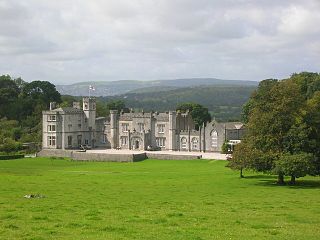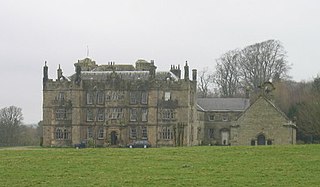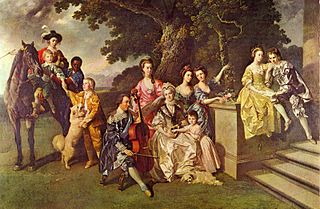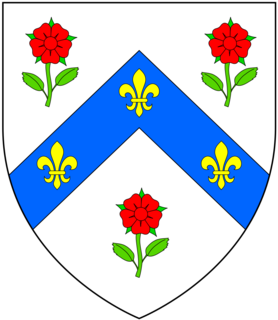Related Research Articles
Baron Ravensworth, of Ravensworth Castle in the County Palatine of Durham and of Eslington Park in the County of Northumberland, is a title in the Peerage of the United Kingdom.

The Swinburne Baronetcy, of Capheaton in the County of Northumberland, was a title in the Baronetage of England. It was created on 26 September 1660 for John Swinburne in honour of the loyalty to Charles I of Swinburne's father and grandfather prior to and during the English Civil War. He demolished Capheaton Castle in 1668 and built a new house on the site. The sixth baronet was member of parliament for Launceston in 1788-9 and High Sheriff of Northumberland in 1799. His grandson, the seventh baronet, was High Sheriff in 1866 and member of parliament for Lichfield 1885–1892. His son, the eighth baronet was High Sheriff in 1920. The title became extinct on the death of the tenth baronet in 1967.
There have been two baronetcies created for members of the Bateman family, one in the Baronetage of England and one in the Baronetage of the United Kingdom. The Batemans had their origins in Norfolk but settled at Hartington, Derbyshire in the 16th century.

There have been two baronetcies created for members of the Knightley family, one in the Baronetage of England and one in the Baronetage of Great Britain. Both creations are extinct. The Knightley family originated at the Staffordshire manor of Knightley, acquired by them shortly after the Norman Conquest of 1066. In 1415 Sir Richard Knightley purchased the manor of Fawsley in Northamptonshire, where the senior line of the family became seated.
There have been two baronetcies created for members of the Blackett family, both in the Baronetage of England. One creation is extant as of 2013. The Blackett family can be traced back to the Blacketts/Blakheveds of Woodcroft, County Durham, some of whom became highly successful in the lead and coal mining industries in Northumberland and County Durham.

There have been six baronetcies created for persons with the surname Middleton, four in the Baronetage of England, one in the Baronetage of Great Britain and one in the Baronetage of the United Kingdom. One creation is extant as of 2008.

Chipchase Castle is a 17th-century Jacobean mansion incorporating a substantial 14th-century pele tower, which stands north of Hadrian's Wall, near Wark on Tyne, between Bellingham and Hexham in Northumberland, England. It is a Scheduled Ancient Monument and a Grade I listed building.
There have been four baronetcies for persons with the surname Blake, one in the Baronetage of Ireland, two in the Baronetage of Great Britain and one in the Baronetage of the United Kingdom. Two of the creations are extant as of 2010. The Blake Baronetcy, of Menlough in the County of Galway, was created in the Baronetage of Ireland on 10 July 1622 for Valentine Blake, Mayor of Galway in 1611 and 1630 and a member of the Irish House of Commons for Galway. His grandfather Thomas Blake had preceded him as Mayor. The second Baronet was a member of the Irish Parliament for Galway Borough. The third Baronet represented both County Galway and Galway Borough in Parliament. The sixth Baronet was a member of the Irish House of Commons for County Galway. He was the first Catholic gentlemen of distinction to join William of Orange. The twelfth Baronet represented Galway Borough in the British House of Commons. The fourteenth Baronet was high sheriff of County Galway in 1872. See also the Blake Baronetcy of Twizell Castle below.

There have been five baronetcies created for persons with the surname Young, one in the Baronetage of England, one in the Baronetage of Great Britain and three in the Baronetage of the United Kingdom. As of 2014, four of the creations are extant.
There have been six baronetcies created for persons with the surname of Lawson, two in the Baronetage of England and four in the Baronetage of the United Kingdom. Two creations are extant as of 2010.
There have been six Forster Baronetcies, four in the Baronetage of England, one in the Baronetage of Ireland and one in the Baronetage of the United Kingdom. All are extinct.
There have been three baronetcies created for persons with the surname Bellingham, one in the Baronetage of England, one in the Baronetage of Ireland and one in the Baronetage of Great Britain. As of 2014 one creation is extant.
There have been five baronetcies created for persons with the surname of White, one in the Baronetage of Great Britain and four in the Baronetage of the United Kingdom. The baronets include Blagdon in the County of Northumberland, Tuxford and Wallingwells in the County of Nottingham, Cotham House in Bristol, Salle Park in the County of Norfolk, and Boulge Hall in the County of Suffolk.
There have been five Wallace Baronetcies; two in the Baronetage of Nova Scotia, and three in the Baronetage of the United Kingdom. All are now extinct.

There have been two Charlton Baronetcies:-

There have been six baronetcies created for members of the Corbet family, four in the Baronetage of England, one in the Baronetage of Great Britain and one in the Baronetage of the United Kingdom. All creations are extinct. The recipients were descendants of the ancient Norman family of Corbet which held substantial estates in Shropshire including Wattlesborough, Caus Castle, Moreton Corbet Castle and Acton Reynald Hall.

There have been three baronetcies created for descendants of the ancient Norman family of Molyneux who were granted extensive estates in Lancashire after the Norman Conquest.
There have been two Baronetcies created for persons with the surname Strachan, both in the Baronetage of Nova Scotia. Both are currently either extinct or dormant.

There have been four baronetcies created for persons with the surname Cope.

There have been four baronetcies created for persons with the surname Martin, one in the Baronetage of England, one in the Baronetage of Great Britain and two in the Baronetage of the United Kingdom. All creations are now extinct.
References
- ↑ The Baronetage of England, Containing a Genealogical and Historical Account of all the Baronetcies now existing Vol 2. Edward Kimber and Richard Johnson (1771), p. 275. Google Books
- ↑ Debrett's Baronetage of England 7th Edition. Ed. William Courthorpe (1839) p209. Google Books